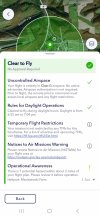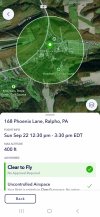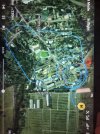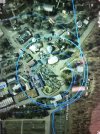I recently shot video over Knoebel's Amusement park and shared the footage with the park through Facebook, thanking them for the fun day. When I arrived, I shot the drone footage and then went into the park to ride all of the roller coasters. I used a combination of my smartphone and Rayban Meta AI glasses to record the footage inside the park.
I'm a fairly new drone pilot and I'm looking for feedback if I'm in the wrong or if I'm flying safely in this situation.
Requested and received LAANC approval to fly over Knoebel's Amusement park last Sunday and I have a million dollar liability policy in the event of property damage or injury to a person.
While flying, I orbited around the outer perimeter of the park and tried to stay over trees, buildings or areas where there were little to no people below. I kept the drone in line of sight as I orbited around the park for the drone shots. Here's the video, then I'll post the conversation between Knoebel's Facebook page ane myself
Had a great time at your park yesterday. Feel free to use any of this footage!
Hi Keith - Drones are not permitted at Knoebels.
The flight was cleared by the FAA.
Drones are not permitted at Knoebels due to moving rides and crowds of unprotected individuals.
Not trying to be difficult or argue, but Knoebels doesn't control the air space. The FAA does. I requested permission to fly from the FAA and was told I was clear to fly.
Plus I have a million dollar liability policy and my drone is registered with the FAA
Hersheypark said I couldn't fly also, but I went into Derry Twp. Police and asked just to verify I was right, and an officer there told me all air space is controlled by the FAA, and I was good to go if I had FAA approval.
We do not own the airspace, correct. However, FAA states: The remote pilot needs to take into account the small unmanned aircraft’s course, speed, and trajectory, including the possibility of a catastrophic failure, to determine if the small unmanned aircraft would go over or strike a person not directly involved in the flight operation (non-participant). In addition, the remote pilot must take steps using a safety risk-based approach to ensure that: the small unmanned aircraft does not operate over non-participants who are not under a covered structure or in a stationary covered vehicle; the small unmanned aircraft will pose no undue hazard to other aircraft, people, or property in the event of a loss of control of the aircraft for any reason (§ 107.19); and the small UAS is not operated in a careless or reckless manner so as to endanger the life or property of another (§ 107.23). If the remote pilot cannot comply with these requirements, then the flight must not take place or the flight must be immediately and safely terminated.
With this being the case, a catastrophic failure would, without a doubt, create danger to uncovered non-participants in our crowded park, and it would create an even greater danger in terms of our rides and guests on uncovered rides traveling up to 55MPH such as an Impulse.
It says take into account. And I took the required precautions and assessed the risk. I flew over tree covered areas or buildings along the perimeter, looking in and zoomed in with a high-quality camera and lens from 400 feet. Had there been a catastrophic accident that dropped my drone out of the sky, it would have landed in a wooded area or on a rooftop.
More facts and research to help educate you on this topic: The odds of an amusement park ride hurting a guest are generally higher than the odds of a drone falling from the sky and injuring someone. Here’s why: Frequency of Operation: Amusement park rides operate continuously, sometimes for many hours each day, with thousands of riders. This increases the probability of accidents, even though they are rare. Mechanical failures, operator errors, and rider misuse are potential risks.
Accidents and Safety: While amusement parks have safety protocols, there are still documented cases of ride-related injuries, typically due to mechanical failures or human error. According to statistics from the International Association of Amusement Parks and Attractions (IAAPA), the risk of serious injury on a ride is around 1 in 15.5 million rides. While this is still a very low chance, it’s higher than drone-related incidents.
Drone Incidents: Drones falling from the sky and causing injury are much rarer. Most drone accidents occur due to operator error, battery failure, or technical malfunction, but injuries are significantly less common compared to those caused by amusement park rides. In summary, while both scenarios are rare, the odds of a guest being injured by an amusement park ride are generally higher than the chances of a drone falling from the sky and causing harm.
What the Data Shows: Research on Drone Risk: A study conducted by researchers at George Mason University in 2017 calculated that the risk of a small drone (weighing less than 2 kg) falling and killing someone is about 1 in 20 million. This estimate is based on accident data and assumptions about the likelihood of drone failures, the density of people in areas where drones are flown, and the potential for drones to cause harm when they fall.
Drone Impact Studies: The FAA and other agencies have conducted tests on drone impacts to assess potential risks. These studies show that the energy generated by a falling drone could theoretically cause injury, but most commercial and recreational drones are small and light enough that the chance of severe injury is low. Larger drones pose a higher risk, but even in those cases, documented incidents of falling drones causing serious harm are virtually nonexistent.
Documented Cases: While drones have caused minor injuries, there are very few documented cases of drones falling from the sky and seriously injuring someone:Minor Incidents: There have been isolated incidents where drones have crashed into people, mostly resulting in minor injuries such as cuts or bruises. For example, during the 2015 US Open, a small drone crashed into empty seating, and no one was injured.
No Known Fatalities: As of now, there are no widely reported cases of a drone falling from the sky and killing someone, and only a few documented cases of drones causing moderate injuries.
The majority of drone-related incidents involve collisions with buildings or other objects rather than people.
Conclusion: While there is always some risk when flying objects are involved, the odds of a drone falling out of the sky and injuring someone are exceedingly low, and there have been very few documented cases of this actually happening. The overall risk to individuals from drone-related incidents remains minimal.
Over the past 50 years, there have been approximately 50 to 100 documented deaths at amusement parks in the U.S.
1 in 15 million chance of injury from a ride and 1 in 20 million chance of a drone falling from the sky and hurting someone.
I would appreciate your feedback!
I'm a fairly new drone pilot and I'm looking for feedback if I'm in the wrong or if I'm flying safely in this situation.
Requested and received LAANC approval to fly over Knoebel's Amusement park last Sunday and I have a million dollar liability policy in the event of property damage or injury to a person.
While flying, I orbited around the outer perimeter of the park and tried to stay over trees, buildings or areas where there were little to no people below. I kept the drone in line of sight as I orbited around the park for the drone shots. Here's the video, then I'll post the conversation between Knoebel's Facebook page ane myself
Had a great time at your park yesterday. Feel free to use any of this footage!
Hi Keith - Drones are not permitted at Knoebels.
The flight was cleared by the FAA.
Drones are not permitted at Knoebels due to moving rides and crowds of unprotected individuals.
Not trying to be difficult or argue, but Knoebels doesn't control the air space. The FAA does. I requested permission to fly from the FAA and was told I was clear to fly.
Plus I have a million dollar liability policy and my drone is registered with the FAA
Hersheypark said I couldn't fly also, but I went into Derry Twp. Police and asked just to verify I was right, and an officer there told me all air space is controlled by the FAA, and I was good to go if I had FAA approval.
We do not own the airspace, correct. However, FAA states: The remote pilot needs to take into account the small unmanned aircraft’s course, speed, and trajectory, including the possibility of a catastrophic failure, to determine if the small unmanned aircraft would go over or strike a person not directly involved in the flight operation (non-participant). In addition, the remote pilot must take steps using a safety risk-based approach to ensure that: the small unmanned aircraft does not operate over non-participants who are not under a covered structure or in a stationary covered vehicle; the small unmanned aircraft will pose no undue hazard to other aircraft, people, or property in the event of a loss of control of the aircraft for any reason (§ 107.19); and the small UAS is not operated in a careless or reckless manner so as to endanger the life or property of another (§ 107.23). If the remote pilot cannot comply with these requirements, then the flight must not take place or the flight must be immediately and safely terminated.
With this being the case, a catastrophic failure would, without a doubt, create danger to uncovered non-participants in our crowded park, and it would create an even greater danger in terms of our rides and guests on uncovered rides traveling up to 55MPH such as an Impulse.
It says take into account. And I took the required precautions and assessed the risk. I flew over tree covered areas or buildings along the perimeter, looking in and zoomed in with a high-quality camera and lens from 400 feet. Had there been a catastrophic accident that dropped my drone out of the sky, it would have landed in a wooded area or on a rooftop.
More facts and research to help educate you on this topic: The odds of an amusement park ride hurting a guest are generally higher than the odds of a drone falling from the sky and injuring someone. Here’s why: Frequency of Operation: Amusement park rides operate continuously, sometimes for many hours each day, with thousands of riders. This increases the probability of accidents, even though they are rare. Mechanical failures, operator errors, and rider misuse are potential risks.
Accidents and Safety: While amusement parks have safety protocols, there are still documented cases of ride-related injuries, typically due to mechanical failures or human error. According to statistics from the International Association of Amusement Parks and Attractions (IAAPA), the risk of serious injury on a ride is around 1 in 15.5 million rides. While this is still a very low chance, it’s higher than drone-related incidents.
Drone Incidents: Drones falling from the sky and causing injury are much rarer. Most drone accidents occur due to operator error, battery failure, or technical malfunction, but injuries are significantly less common compared to those caused by amusement park rides. In summary, while both scenarios are rare, the odds of a guest being injured by an amusement park ride are generally higher than the chances of a drone falling from the sky and causing harm.
What the Data Shows: Research on Drone Risk: A study conducted by researchers at George Mason University in 2017 calculated that the risk of a small drone (weighing less than 2 kg) falling and killing someone is about 1 in 20 million. This estimate is based on accident data and assumptions about the likelihood of drone failures, the density of people in areas where drones are flown, and the potential for drones to cause harm when they fall.
Drone Impact Studies: The FAA and other agencies have conducted tests on drone impacts to assess potential risks. These studies show that the energy generated by a falling drone could theoretically cause injury, but most commercial and recreational drones are small and light enough that the chance of severe injury is low. Larger drones pose a higher risk, but even in those cases, documented incidents of falling drones causing serious harm are virtually nonexistent.
Documented Cases: While drones have caused minor injuries, there are very few documented cases of drones falling from the sky and seriously injuring someone:Minor Incidents: There have been isolated incidents where drones have crashed into people, mostly resulting in minor injuries such as cuts or bruises. For example, during the 2015 US Open, a small drone crashed into empty seating, and no one was injured.
No Known Fatalities: As of now, there are no widely reported cases of a drone falling from the sky and killing someone, and only a few documented cases of drones causing moderate injuries.
The majority of drone-related incidents involve collisions with buildings or other objects rather than people.
Conclusion: While there is always some risk when flying objects are involved, the odds of a drone falling out of the sky and injuring someone are exceedingly low, and there have been very few documented cases of this actually happening. The overall risk to individuals from drone-related incidents remains minimal.
Over the past 50 years, there have been approximately 50 to 100 documented deaths at amusement parks in the U.S.
1 in 15 million chance of injury from a ride and 1 in 20 million chance of a drone falling from the sky and hurting someone.
I would appreciate your feedback!
















